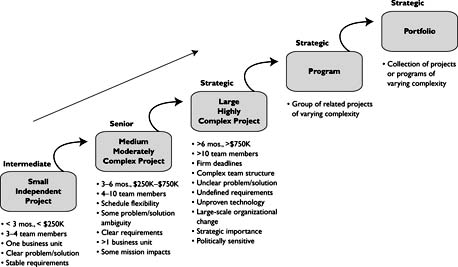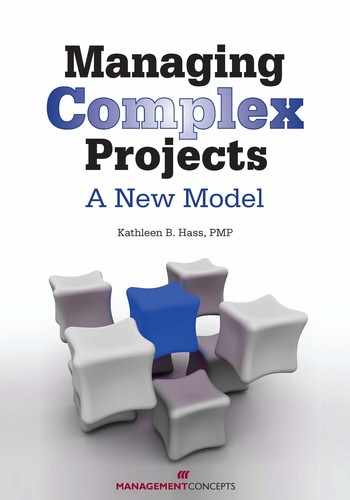CHAPTER 5
Developing Leaders of Complex Projects
As organizations depend more and more on project outcomes to achieve their strategic goals, they are developing career paths for their project leadership positions, including project managers, business analysts, lead technologists (architects and developers), and business visionaries. Organizations that are undergoing pivotal transitions require leaders who exhibit characteristics and follow a career path that differs in certain respects from the characteristics and career path of traditional project leaders. Complexity thinking can assist organizations in identifying and developing these leaders.
TRADITIONAL PROJECT LEADER CAREER PATH
The traditional project leader career path starts with entry-level associates who are mainly in support positions and transitions to strategic-level project leaders who lead critical, complex projects (Table 5-1).
TABLE 5-1. Traditional Project Leader Career Path
| Level | Proficiency | Responsibilities | Competencies |
|---|---|---|---|
| Strategic |
|
|
|
| Senior |
|
|
|
| Intermediate |
|
|
|
| Associate |
|
|
|
EMERGING COMPLEX PROJECT MANAGER CAREER PROGRESSION
The Australian Competency Standard for Complex Project Managers proposes a new four-tiered career path:
 Project manager
Project manager Traditional senior project manager
Traditional senior project manager Program manager
Program manager Complex project manager.
Complex project manager.
While this structure is not yet fully accepted in the project management community, it is certainly food for thought as we consider the competencies needed to manage complex projects successfully. The standard also proposes certification levels for traditional and complex project managers (Table 5-2) and describes four competency levels for each action in the workplace (Table 5-3).1
TABLE 5-2. Complex Project Manager Certification Levels
| Traditional | Complex | |||
|---|---|---|---|---|
| Project Manager | Senior Project Manager | Program Manager | Member | Fellow |
TABLE 5-3. Complex Project Manager Competency Model
| Traditional | Complex | ||||
|---|---|---|---|---|---|
| Actions in workplace | Project Manager | Senior Project Manager | Program Manager | Member | Fellow |
| Develops vision statement, values charter, code of conduct, and mission statement | D | D | P | C | L |
| Maps stakeholder alignment/ differences over the project life cycle | D | D | P | C | L |
Key:
D - development
P - practitioner
C - competent
L - leader
For each action in the workplace, certification levels are defined as follows:
 Development. The project manager applies the competency under direct supervision.
Development. The project manager applies the competency under direct supervision. Practitioner. The project manager applies the competency without the need for direct supervision, but within the bounds of standardized processes, procedures, and systems.
Practitioner. The project manager applies the competency without the need for direct supervision, but within the bounds of standardized processes, procedures, and systems. Competent. The project manager applies the competency without the need for direct supervision, provides direct supervision of the competency for others, and mentors development of the competency in others.
Competent. The project manager applies the competency without the need for direct supervision, provides direct supervision of the competency for others, and mentors development of the competency in others. Leader. The project manager provides professional leadership in the competency; leads in the design of processes, procedures, and systems; and has the ability to use the competency flexibly and creatively.
Leader. The project manager provides professional leadership in the competency; leads in the design of processes, procedures, and systems; and has the ability to use the competency flexibly and creatively.
SUCCESSFUL LEADERSHIP CHARACTERISTICS FOR ORGANIZATIONS UNDERGOING PIVOTAL TRANSITIONS
As we work to identify and develop leaders of complex projects, we examine a model for exceptional organizational leadership presented by Jim Collins. Collins provides us with researched-based information on the characteristics of business leaders whose companies are exceptionally successful during pivotal transition periods; these characteristics are also relevant to project leaders who are successful in leading complex projects.
Collins describes these leaders as very ambitious but also very humble. Their ambition is first for the organization rather than for themselves, and their goal is to leave the legacy of a successful enterprise. Characteristics of these leaders, which Collins refers to as “level 5 leaders,” include a compelling personal humility coupled with an unwavering resolve that he calls “professional will.” Collins describes a leader with personal humility as someone who:2
Demonstrates a compelling modesty, virtually shunning public praise
 Acts with quiet, calm determination
Acts with quiet, calm determination Channels ambitions into the company; identifies and mentors successors for even greater success
Channels ambitions into the company; identifies and mentors successors for even greater success Attributes success to others. A leader who exhibits professional will: Creates superb results
Attributes success to others. A leader who exhibits professional will: Creates superb results Demonstrates an unwavering resolve to do whatever it takes to produce the best long-term results for the enterprise
Demonstrates an unwavering resolve to do whatever it takes to produce the best long-term results for the enterprise Sets the standard of building an enduring great company
Sets the standard of building an enduring great company Attributes responsibility for poor results to himself.
Attributes responsibility for poor results to himself.
We submit that leaders of complex projects should strive to become level 5 leaders, doing whatever it takes to produce the best long-term results. We have adapted Collins’ path to level 5 leadership to depict the path to becoming a complex project leader (see Table 5-4).
TABLE 5-4. Complex Project Leader Development Path
| Leadership Level | Leadership Characteristics |
|---|---|
| Level 1 | Highly Capable Individual Contributes to project success through individual expertise, talent, knowledge, skills, and good work habits |
| Level 2 | Contributing Team Member Contributes individual capabilities to the achievement of business objectives and works effectively with others |
| Level 3 | Competent Project Leader Organizes people and resources toward the effective and efficient pursuit of business objectives |
| Level 4 | Exceptional Project Leader Commits to vigorous pursuit of a clear and compelling project vision, stimulating higher performance standards with a track record of project success |
| Level 5 | Complex Project Leader Brings about business transformation in pursuit of new business strategies through personal and professional leadership |
USING COMPLEXITY THINKING TO ASSIGN COMPLEX PROJECT LEADERS
To make the most appropriate project leadership assignments, management must consider project complexity. Figure 5-1 maps the generic career levels presented earlier with the project profiles contained in our Project Complexity Model. As depicted, strategic-level leaders are needed to manage not only highly complex projects, but programs (groups of projects managed in a coordinated way to obtain greater benefits) and portfolios (collections of projects or programs managed together to achieve strategic goals) as well.

FIGURE 5-1. Project Leadership Capability Maturity Model
Organizations are recognizing that complex projects require an exceptional leadership team of experts and are developing career paths for their project leadership positions—project managers, business analysts, lead technologists (architects and developers), and business visionaries—accordingly.
Based on the project profile diagnosed using the Project Complexity Model, organizations undergoing pivotal transitions can apply complexity thinking when considering assignments for complex project leaders. Projects need no longer fail because the key project leadership positions are filled with individuals who are not sufficiently skilled and practiced to make the appropriate managerial decisions about the project, build and sustain a high-performing project team, and adapt to changes as the project unfolds.
NOTES
1. Commonwealth of Australia (Department of Defence), College of Complex Project Managers and Defence Materiel Organisation, “Competency Standard for Complex Project Managers,” Public Release Version 2.0 (2006). Online at http://www.defence.gov.au/dmo/proj_man/Complex_PM_v2.0.pdf (accessed January 2008), 17-18.
2. Jim Collins, Good to Great: Why Some Companies Make the Leap…and Others Don’t (New York: HarperCollins Publishers, Inc., 2001), 36.
CONCLUSION TO PART II
Projects no longer need fail because key leadership positions are filled with individuals who are not up to the challenge. In Part II we presented the information organizations need to make effective leadership assignments for complex projects. We proposed that:
 Complex projects require collaborative team leadership, not simply a senior project manager
Complex projects require collaborative team leadership, not simply a senior project manager Career paths to develop leaders of complex projects are emerging
Career paths to develop leaders of complex projects are emerging Proven models exist for successful leaders of organizations that can be readily applied to leaders of complex projects
Proven models exist for successful leaders of organizations that can be readily applied to leaders of complex projects Using the Project Complexity Model to assign project managers and other key project leadership positions will help ensure that you get “the right stuff” on your team.
Using the Project Complexity Model to assign project managers and other key project leadership positions will help ensure that you get “the right stuff” on your team.
